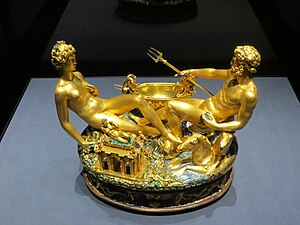| Cellini Salt Cellar | |
|---|---|
| Italian: Saliera | |
 | |
| Artist | Benvenuto Cellini |
| Year | 1543 |
| Type | Partly enameled gold sculpture |
| Dimensions | 26 cm × 33.5 cm (10 in × 13.2 in) |
| Location | Kunsthistorisches Museum, Vienna |

The Cellini Salt Cellar (in Vienna called the Saliera, Italian for salt cellar) is a part-enamelled gold table sculpture by Benvenuto Cellini (c.1500-1571). It was completed in 1543 for Francis I of France (r.1515-1547), from silver plate models that had been prepared many years earlier for Cardinal Ippolito d'Este (c.1479-1520).
Functioning as more than just an expensive condiment holder, the cellar aimed to catapult conversation among intellectuals on the underlying meanings of the work.[1] During the Renaissance, the Saliera was notable for its Mannerism.[2] The main draw is the work's style and form, which Cellini discusses in his treatise, I trattati dell'oreficieria e della Scultura (Treatises on Goldsmithing and Sculpture) and in his autobiography.[3][4][5] The work is the only extant gold sculpture by Benvenuto Cellini and is most famous of extant gold sculpture work to survive from the Renaissance. Ultimately, acting as a paradigm for 'renaissance gold smithery,' the sculptor showcased the multifaceted meanings of small objects of the era.[6]
Famously stolen in 2003, the salt cellar was recovered in 2006 and the thief was imprisoned.
- ^ Blow, Alice (2021). "Benvenuto Cellini, Salt Cellar". smarthistory.org. Retrieved 2023-03-31.
- ^ Gallucci, Margaret A.; Rossi, Paolo L., eds. (2004). Benvenuto Cellini: Sculpture, Goldsmith, Writer. Cambridge, UK: Cambridge University Press. pp. 71–78. ISBN 978-0521816618.
- ^ Gardner, Victoria C. (1997). "Homines non nascuntur, sed figuntur: Benvenuto Cellini's Vita and Self-Presentation of the Renaissance Artist". The Sixteenth Century Journal. 28 (2): 447–465. doi:10.2307/2543453. ISSN 0361-0160. JSTOR 2543453. S2CID 165889629.
- ^ "The treatises of Benvenuto Cellini on goldsmithing and sculpture : Cellini, Benvenuto, 1500-1571". Internet Archive. March 25, 2023. Retrieved April 9, 2024.
- ^ "The Autobiography of Benvenuto Cellini by Benvenuto Cellini". Project Gutenberg. May 1, 2003. Retrieved April 9, 2024.
- ^ Hartt, Frederick; Wilkins, David G. (2011). History of Italian Renaissance Art: Painting, Sculpture, Architecture. Upper Saddle River, NJ: Pearson/Prentice Hall. pp. 662–663. ISBN 978-0-205-70581-8. OCLC 768783778.